The Digital Sensor: A Guide to Understanding Digital Cameras
by Wesley Fink on April 21, 2008 1:00 AM EST- Posted in
- Digital Camera
Bayer vs. Foveon
This title is something of a misstatement, as it would more accurately be Foveon/Sigma versus everyone else in the world. All DSLR imaging sensors except the Foveon use Bayer technology. Digital color images are created by capturing red, blue, and green pixels and then combining them to create a full color image.
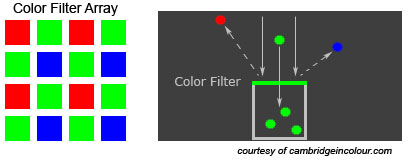
All current sensors except one use Bayer technology. The sensor consists of X megapixels, or light gathering cavities. The sensor is covered with a Bayer array, which is a series of microlenses that allow only certain colors to fall in certain cavities (or pixels). The microlenses are arranged in a defined grid that consists of alternating red-green and green-blue filters.
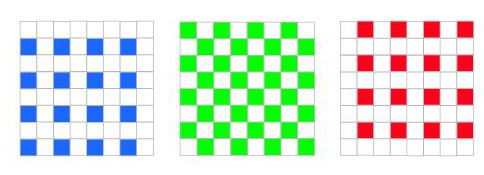
If you noticed there are twice as many green as red or blue areas in the above image, that is by design in the Bayer array. The human eye is more sensitive to green light than red or blue and the Bayer array uses this fact to produce images that appear to have finer detail and less noise. The doubling of the green receptors is corrected in the image processing.
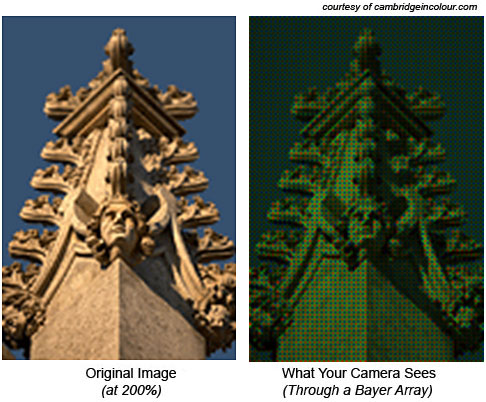
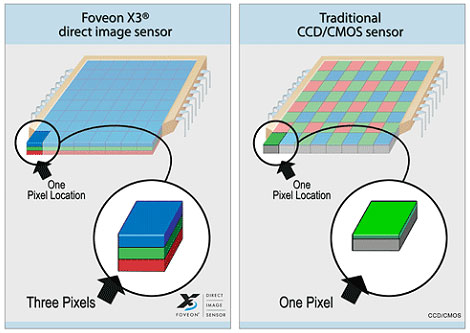
There is no demosaicing or interpolation step with the Foveon sensor. Where before there was one pixel of color information, the Foveon is now capturing red, green, and blue data pixels in the same pixel location. On the surface, this certainly appears a superior way of capturing color images, but things are not always as they appear. It is fair to ask: if this approach is so good then why is Sigma, a minor player in the digital camera market, the only company to embrace the Foveon sensor? A closer look at Foveon specs helps to understand some of the issues.
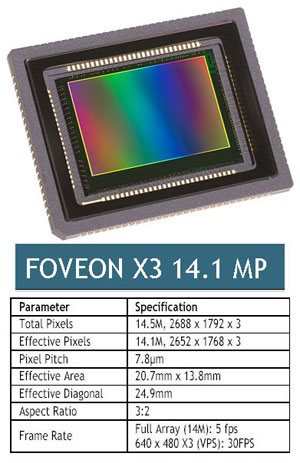
The top current Foveon sensor is the 14.1MP Foveon used in the Sigma SD14 digital camera. Foveon gets to the 14.1MP total by counting all pixels used to create the finished image, which is 2688x1768 pixels or 4.7MP. Many would argue this is fair since each pixel in a competing 14.1MP is only collecting one piece of color information. However, the practical reality is that a 14.1MP Foveon is reported to be about equivalent to an 8MP Bayer DSLR when shooting JPEGs and about as good a 10MP camera when shooting in the preferred and native RAW mode. The apparent resolution then is somewhere between the 4.7MP image size and the 14.1MP that are used to create that image.
Several other issues have also held back Foveon. Where the best Bayer cameras can now capture useful images at ISO 1600, 3200, or even higher, the Foveon sensor is best at lower ISOs. It is usable to about ISO 400 and then noise climbs rapidly as the ISO increases. The latest SD14 Foveon is reported to be better in ISO sensitivity, but it still falls far short of the extended ISO performance of its competition.
The other major issue with the Foveon sensor is that the separation into 3 distinct colors for each pixel site is not nearly as straightforward as Foveon describes it. The captured image still requires a lot of image processing to extract the 3 colors from each pixel site and reconstruct the finished image. In fact some critics claim the image processing required by the Foveon sensor is even more extensive than Bayer Array demosaicing. The purer the data in any extraction process the more faithful it is to the original capture, so the Foveon sensor may offer fewer "post-processing" advantages than it first appears. When conditions and lighting are correct the Foveon can deliver stunning images, but things in photography are rarely perfect.
For the purpose of our discussion the Foveon is more a novelty than a sensor you will likely use today. Despite its limited availability, however, the concept of the Foveon sensor is as compelling as ever, and you can actually buy a production camera, the Sigma SD14, that uses this sensor. As you can see from the specs, the sensor size is 20.7x13.8mm, which places the Foveon between the Canon small APS C and the Olympus 4/3 sensor. The lens multiplier is 1.7X.










72 Comments
View All Comments
andrewln - Monday, April 21, 2008 - link
This was followed in about 6 months by the introduction of the Samsung 14.6MP CMOS sensor in the Pentax D20.should be Pentax K20D
Wesley Fink - Monday, April 21, 2008 - link
Typo corrected. Unfortunately spell check can't catch model numbers that are misstated.araczynski - Monday, April 21, 2008 - link
now i know what pc tech illiterate people feel like :)its a good thing i don't care about photography, interesting read none the less.
finbarqs - Monday, April 21, 2008 - link
the thing is, I've read the reviews and saw the comparisons between the 5D and the D200 (I believe that was the last CCD sensor that Nikon used). The 5D has way better per-pixel sharpness than the D200. Perhaps the technology of the CMOS made it so it finally "looks" better than the CCD. Or at least on the Canon side of things. I'm not biased towards any camera. I've own an XTi, 5D, Panasonic DMC-L1, and now a D300. I'm hoping to own the next 5D MKII (or whatever they call it).Even the D2X used a CMOS sensor, and I thought Nikon made the D300 sensor, as well as the D3 sensor (FF). What I also find "funny" is that Sony doesn't have a FF sensor yet, but nikon does, thus leaving me to believe that Nikon came up with their own FF sensor.
melgross - Monday, April 21, 2008 - link
It's Nikon's own design, though I don't remember who makes it.haplo602 - Monday, April 21, 2008 - link
Nice article Wesley, finaly one Anandtech photo related article I enjoyed reading.On note on the growing megapixel count. Sooner more than later, DSLR in APS-C (and later full frame ones) will hit the same technology wall P&S are facing (too small photosite).
This is one factor that makes me a happy film shooter :-) I know that my limit is the scanner up to around 10MP and I have less flexibility in shooting conditions (either 2 bodies or limited by ISO and film type), in every other situation I am equal or better off.
I am waiting for an affordable Nikon full frame body and then I will make my switch to digital (but that is yet years to come).
wally626 - Monday, April 21, 2008 - link
A sensor technology improves APS-C will be able to go to high enough pixel counts and have very good quality. For most consumers some where around 12 MP is enough, if the sensors improve to where this can hit 3200 ISO with low noise 99 percent of the market would be satisfied.The full frame bodies will replace the medium formats of the film world. There have been some really good medium format cameras that take much better images than 35mm but very few are sold. I think the article is correct in saying the full-frame DSLR will be the PRO cameras and priced as such.
melgross - Monday, April 21, 2008 - link
The number ofpixels is directly related to the print size.If you go by the oft quoted 300 dpi on the final print for maximum quality, you will need a sensor with 2400 x 3600 resolution for a full frame 8 x 12 print, or 8.64 MP. For an 8 x 10, it would be 7.2 MP (4/3 sensor).
For a larger 11 x 17, it would be 3300 x 5100, or 16.83 MP, or 13.86 for the 11 x 14 4/3 sensor print.
You can figure the rest of the sizes my multiplying the inch size of the print edges L x W by 300 to come up with a number.
But the truth is that 240 dpi is going to be good enough fot most prints, and youcan do the numbers that way.
When you know the numbers, you can figure out what size sensor you will need for the highest quality work.
But for most people, even 180 dpi will be enough for their prints. Going to that gives more flexibility, as the sensor pixel count is much smaller.
It's better to get a camera with a longer OPTICAL zoom rather than to go for the biggest number of sensor pixels.
haplo602 - Tuesday, April 22, 2008 - link
^ this ^It's all a matter of print size. I am an amateur/hobbyist, and anything past A4 is large for me. I have printed reasonable quality 8x12 prints from a consumer slide film and home film scanner.
I can hang them up on the wall in a nice frame and they will serve their purpose :-)
Idealy I'd need a 12-14MP full frame Nikon with goot ISO/Noise characteristics (f.e. D3) and it will satisfy my needs for years to come.
Heidfirst - Monday, April 21, 2008 - link
especially as I was wondering the other day what smaller process technology would do for digital sensors?Normally of course smaller process means cooler & more importantly smaller>cheaper to make but of course with sensors you are talking a fixed size so not any cheaper.
But would the potential increased precision of circuitry mean any better image quality?
& a little nitpicking:
Sony didn't buy Konica Minolta (which continues in business) but certain assets from the Photo Imaging division of KM. As to what that actually means there is little hard knowledge outside the 2 companies as it seems that KM still retain some IP & indeed a shareholding in some of the production facilities.
Also, current thinking seems to be that the "A900" may not be called that but something else to differentiate it from the APS-C models.